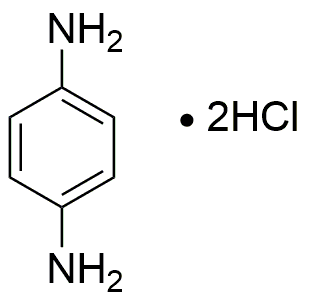1,4-Phenylenediamine dihydrochloride is widely utilized in research focused on:
- Dye Manufacturing: This compound is a key ingredient in the production of azo dyes, which are widely used in textiles and food coloring due to their vibrant colors and stability.
- Polymer Chemistry: It serves as a curing agent in the synthesis of polyurethanes, enhancing the durability and flexibility of materials used in coatings and adhesives.
- Pharmaceuticals: The compound is important in the development of various pharmaceutical intermediates, contributing to the synthesis of active ingredients in medications.
- Analytical Chemistry: It is employed in analytical methods for detecting and quantifying certain metals in environmental samples, providing essential data for pollution control.
- Cosmetics: Used in hair dyes and other cosmetic formulations, it offers effective coloring properties while being subject to strict safety regulations to ensure consumer safety.
General Information
Properties
Safety and Regulations
Applications
1,4-Phenylenediamine dihydrochloride is widely utilized in research focused on:
- Dye Manufacturing: This compound is a key ingredient in the production of azo dyes, which are widely used in textiles and food coloring due to their vibrant colors and stability.
- Polymer Chemistry: It serves as a curing agent in the synthesis of polyurethanes, enhancing the durability and flexibility of materials used in coatings and adhesives.
- Pharmaceuticals: The compound is important in the development of various pharmaceutical intermediates, contributing to the synthesis of active ingredients in medications.
- Analytical Chemistry: It is employed in analytical methods for detecting and quantifying certain metals in environmental samples, providing essential data for pollution control.
- Cosmetics: Used in hair dyes and other cosmetic formulations, it offers effective coloring properties while being subject to strict safety regulations to ensure consumer safety.
Documents
Safety Data Sheets (SDS)
The SDS provides comprehensive safety information on handling, storage, and disposal of the product.
Product Specification (PS)
The PS provides a comprehensive breakdown of the product’s properties, including chemical composition, physical state, purity, and storage requirements. It also details acceptable quality ranges and the product's intended applications.
Certificates of Analysis (COA)
Search for Certificates of Analysis (COA) by entering the products Lot Number. Lot and Batch Numbers can be found on a product’s label following the words ‘Lot’ or ‘Batch’.
*Catalog Number
*Lot Number
Certificates Of Origin (COO)
This COO confirms the country where the product was manufactured, and also details the materials and components used in it and whether it is derived from natural, synthetic, or other specific sources. This certificate may be required for customs, trade, and regulatory compliance.
*Catalog Number
*Lot Number
Safety Data Sheets (SDS)
The SDS provides comprehensive safety information on handling, storage, and disposal of the product.
DownloadProduct Specification (PS)
The PS provides a comprehensive breakdown of the product’s properties, including chemical composition, physical state, purity, and storage requirements. It also details acceptable quality ranges and the product's intended applications.
DownloadCertificates of Analysis (COA)
Search for Certificates of Analysis (COA) by entering the products Lot Number. Lot and Batch Numbers can be found on a product’s label following the words ‘Lot’ or ‘Batch’.
*Catalog Number
*Lot Number
Certificates Of Origin (COO)
This COO confirms the country where the product was manufactured, and also details the materials and components used in it and whether it is derived from natural, synthetic, or other specific sources. This certificate may be required for customs, trade, and regulatory compliance.


